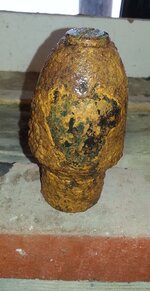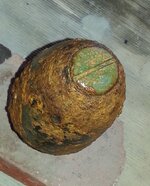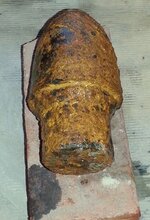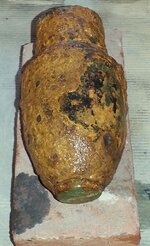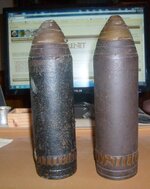genlee
Full Member
- Aug 20, 2011
- 159
- 142
- Detector(s) used
- Whites MXT Pro & Fisher F75 LTD
- Primary Interest:
- All Treasure Hunting
I can check this relic off my bucket list now. This is a Hotchkiss 2 1/2" diameter shell
Tony, Gerry and myself were at a new site on Saturday. Well it is not a new site as in never been hunter, but new for us. I had gone out a few weekends ago to scout it out and found several fired bullets, four to be exact and all I did was walk in a straight line, for one hour.
Ok so back to yesterday, we got to the field around 7:45 am, and got busy.
About any hour into the hunt we all had a few relics, but nothing to right home about. So I head to the top of a ridge, that looked trashy and it was, but nothing to bad, just a lot of digging.
So my Fisher screams at me with a 78 solid signal but it was a high Iron reading, And it was 14+ inches so I figure it has to be something old. And it was right under a large root. After about 30 minutes of digging, probing and digging and probing I start to see the base of the shell. Now I was not sure what it was, as I have dug axles before, so out of the ground this bad boy popped.
I have to say I was a bit intimidated holding an unexploded shell in my hands, so I ran down the hill figuring if I was going to go it was going to be a skip in my step and amile on my face.
So this is my best for the year.
Tony, Gerry and myself were at a new site on Saturday. Well it is not a new site as in never been hunter, but new for us. I had gone out a few weekends ago to scout it out and found several fired bullets, four to be exact and all I did was walk in a straight line, for one hour.
Ok so back to yesterday, we got to the field around 7:45 am, and got busy.
About any hour into the hunt we all had a few relics, but nothing to right home about. So I head to the top of a ridge, that looked trashy and it was, but nothing to bad, just a lot of digging.
So my Fisher screams at me with a 78 solid signal but it was a high Iron reading, And it was 14+ inches so I figure it has to be something old. And it was right under a large root. After about 30 minutes of digging, probing and digging and probing I start to see the base of the shell. Now I was not sure what it was, as I have dug axles before, so out of the ground this bad boy popped.
I have to say I was a bit intimidated holding an unexploded shell in my hands, so I ran down the hill figuring if I was going to go it was going to be a skip in my step and amile on my face.
So this is my best for the year.
Amazon Forum Fav 👍
Attachments
Upvote
14


